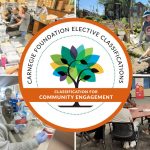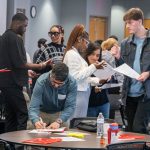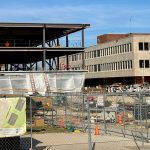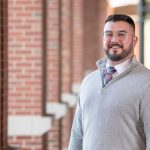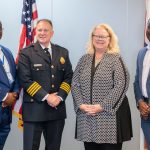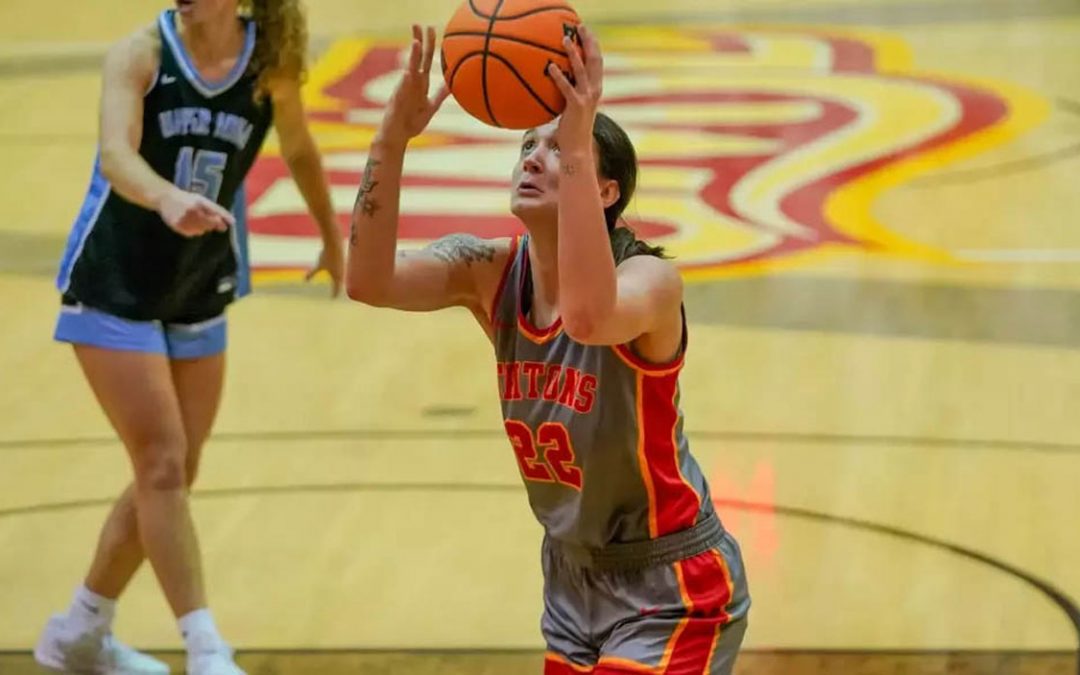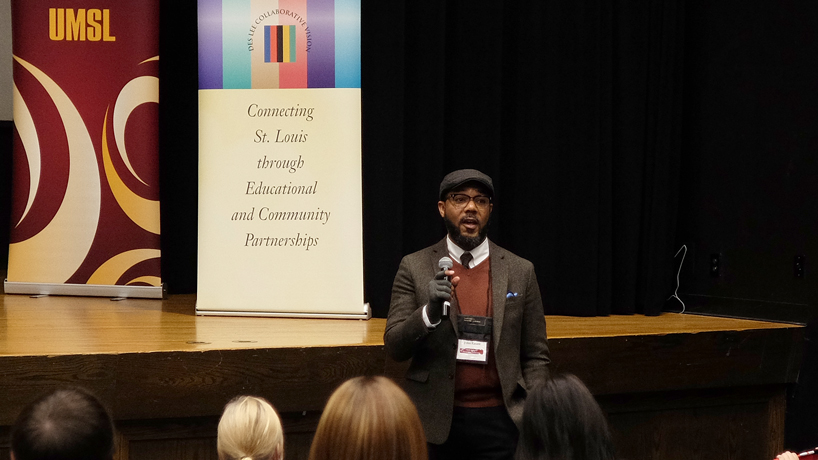
John Eason, an associate professor of sociology at Texas A&M university, delivers a talk on the school to prison pipeline during the 17th annual Youth Violence Prevention Conference. The conference, held last Thursday in the J.C. Penney Auditorium, welcomed practitioners from across the St. Louis region to interact with academics on issues of school violence and school safety. (Photos by Steve Walentik)
School violence and school safety have been recurring topics for national discussion in the United States for going on two decades, but almost always in the context of mass shootings in places such as Littleton, Colorado; Newtown, Connecticut; and Parkland, Florida.
Finn Esbensen, the chair of the Department of Criminology and Criminal Justice, acknowledged as much Thursday morning as he welcomed attendees to the University of Missouri–St. Louis campus for the 17th annual Youth Violence Prevention Conference.
“I think the Columbine shooting in 1999 is sort of the demarcation of the age of innocence,” he said as he spoke from the stage in the J.C. Penney Auditorium.
But Esbensen just as quickly let the crowd know that shootings like what occurred at Columbine or Marjory Stoneman Douglas High School would not be central to the message of the day’s presentations.
“School shootings – as horrific as they are – are statistically rare events,” he said. “From research now, there really are not any proven strategies for dealing with them.
“Another type of school violence is much more prominent and affects the lives of teachers, students, administrators, parents and siblings on an everyday basis.”
He was referring to the more mundane instances of violence – often taking the form bullying or fights between students – that might make a child feel unsafe and avoid school.
The Department of Criminology and Criminal Justice joined the College of Arts and Sciences and the Des Lee Collaborative Vision in sponsoring the conference.
It brought a group of academics from across the country to share research on the impact of everyday school violence while attempting to offer some solutions for the teachers, counselors, school administrators, social workers, law-enforcement officials and family court staffers who made up the majority of those in attendance.
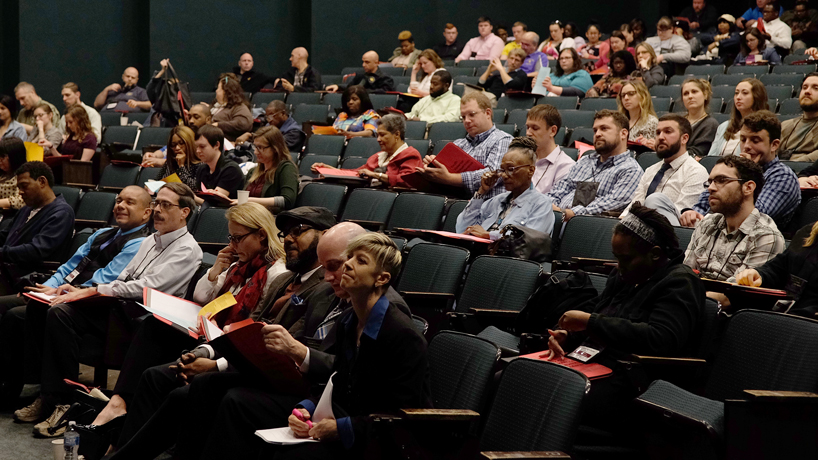
A crowd of about 200 people attended the Youth Violence Prevention Conference on school violence and school safety. Among them were teachers, counselors, administrators, social workers, law-enforcement officials and family court staffers.
Bringing researchers together with practitioners has long been a strength of the conference.
“It’s easy to say, ‘We’ll do our end of research and then just pass it along,’” said doctoral student Jen O’Neill, who was eager to attend the conference after working with Esbensen as a graduate research assistant on the UMSL Comprehensive School Safety Initiative. “I think it’s really important to get all those perspectives in and then really work together and make sure we’re all on the same page about the goal of making schools safer.
“We need to hear people’s perspectives who are working in the schools so they can kind of say, ‘That’s not how that actually plays out.’”
John Eason, an associate professor of sociology at Texas A&M University, joked that he should be taking notes as he darted around the auditorium, interacting with attendees during the morning’s first session.
His presentation focused on the school to prison pipeline – what he defined as “the arrest, punishment and social control policies that push out youth from schools and into juvenile and criminal justice systems.”
He did not shy away from discussing race as a factor central to that phenomenon because of the way it affects one’s life chances.
“We’re not all running the same race, that people’s life chances differ based just by the skin they were born into, the body they were born into – whether they’re male, female, black, Latinx, Asian or white,” Eason said. “And not all white people have equal opportunities. If you’re white and you’re born on the wrong side of the tracks, tough luck for you. I’ve studied rural communities, and I’ve seen a lot of rural whites who are incredibly disadvantaged based on where they are.”
He noted evidence that young people of color have less access to gifted-talented programs and are also more likely to be punished with in-school or out-of-school suspensions or referred to the juvenile justice system – all things that take them out of the classroom.
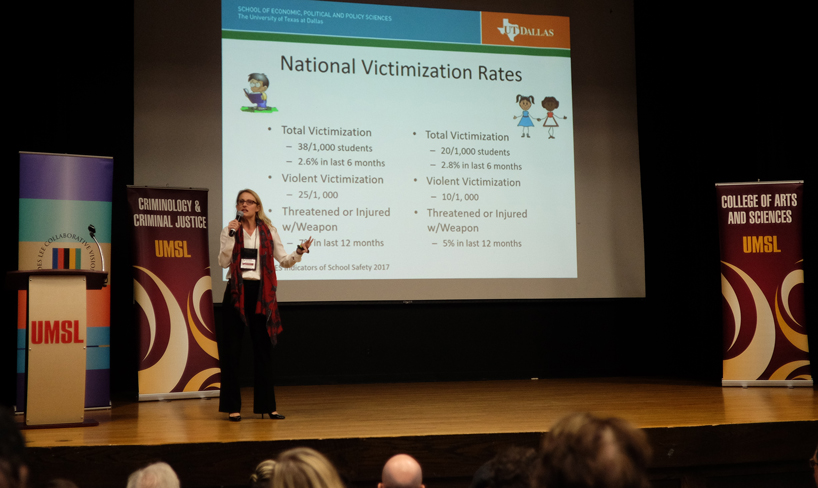
Nadine Connell, an associate professor in the criminology program at the University of Texas at Dallas, discusses national victimization rates of students as she presents on school safety issues and gender.
Nadine Connell, an associate professor in the criminology program at the University of Texas at Dallas, gave her presentation on “School safety issues and gender: Understanding risk factors and responses.”
She shared results from research she conducted in New Jersey into the different ways middle school boys and girls experience bullying and victimization and tried to offer some ideas for improving school climate.
“I know we’re here talking about youth violence, and we’re here talking about the things that we want to change, but we have to have the flipside of that conversation, which is that most kids are good kids,” Connell said. “Our goal in the juvenile justice system is to make sure that one mistake doesn’t turn into the school to prison pipeline, doesn’t turn into negative consequences because of things like oppressive school justice.”
She stressed the upside in effectively managing more minor issues inside a classroom is that it frees up resources to try to help the most high-risk students.
Dana Peterson, an associate professor of criminal justice at the University at Albany, wrapped up the morning sessions by speaking about research on how LGBTQ students experience school violence and school safety.
She cited data from a national survey by GLSEN, a gay, lesbian, bisexual, transgender and queer advocacy group, that showed nearly 60 percent of LGBTQ youth have experienced bullying and more than a quarter have been physically attacked at school.
The victimization leaves them more likely to miss school, which is detrimental to their education.
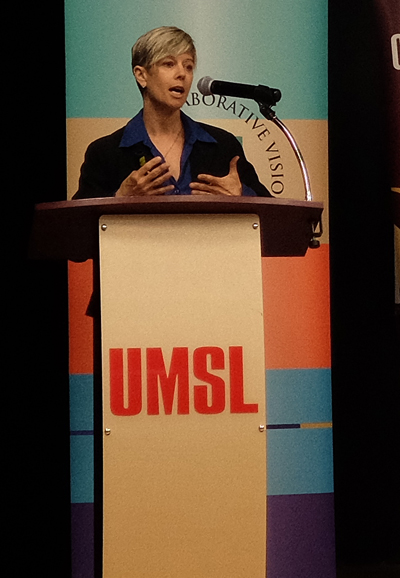
Dana Peterson, an associate professor of criminal justice at the University at Albany, presents on the how LGBTQ students experience school violence and school safety.
“They don’t feel like they belong, they don’t feel connected to school, they don’t feel attached to the school community that would help them integrate and really focus on their studies,” Peterson said.
Student Brian Rainey, who is completing his bachelor’s degree this semester and preparing to enter the doctoral program in the fall, has an interest researching the victimization of those in the LGBTQ community and how they react and stand up against it. He was particularly impressed by Peterson’s presentation.
“I’d met Dana a month or two ago,” Rainey said. “She’s just a great person, and her academic work is just impeccable. It’s fantastic.”
The afternoon featured presentations from Anthony Peguero, an associate professor of sociology at Virginia Tech, on “School order, justice, and education: Climate, discipline practices, and dropping out” and Chris Melde, an UMSL alumnus and associate professor of criminal justice at Michigan State University, on “Challenges associated with implementing school-wide interventions.”
“Historically, research on school climate is very straight forward,” Peguero said. “We’re looking at relationships within the school – not only relationships between students and teachers, but also relationships between your faculty and staff, school resources, community stakeholders. All these things matter.”
Melde shared research he’s done in Flint, Michigan, and his presentation also highlighted how factors outside the school can affect school violence and school safety.
“His presentation specifically I found really interesting,” O’Neill said, “just to remind me that, ‘Yes, I’m very interested in the school, but take a step back and realize how the school is connected to the community.’”
Media Coverage
St. Louis Public Radio



